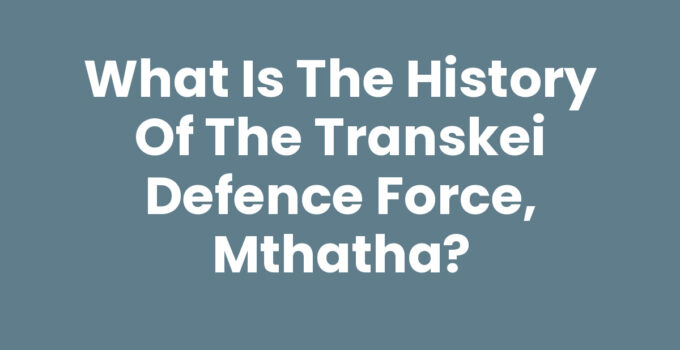The Transkei Defence Force (TDF) has played a significant role in the socio-political landscape of South Africa, particularly during the apartheid era. This article delves into the origins, evolution, and lasting impacts of the TDF, unearthing its history rooted in the Mthatha region.
What Is The History Of The Transkei Defence Force, Mthatha?
The Transkei Defence Force was established in 1976 as part of the Bantustan policy, a system introduced by the apartheid government. The Transkei was one of several areas designated for black South Africans, intended to serve as semi-autonomous homelands. Mthatha, as the capital of Transkei, became the center for the military force charged with protecting the regime’s interests.
Initially, the TDF was composed mainly of men recruited from the local populace. Many of these recruits were influenced by the socio-economic conditions of the time, where limited opportunities existed. The objective was to create a local military force that would help assert the government’s control over the region and prevent unrest among the black population.
The TDF was grouped under the Ministry of Defence of Transkei and was supported by the South African Defence Force (SADF), reflecting the broader political dynamics of apartheid. The South African government aimed to strain growing nationalist sentiments and the anti-apartheid movement by fostering a loyal force within the Transkei. Under the leadership of notable figures like Brigadier General T.Y. Gqoboka, the TDF attempted to establish a sense of military pride and discipline among its ranks.
Throughout the late 1970s and early 1980s, the TDF played a crucial part in various military operations, primarily involving border control and internal security. Their role included suppressing any dissent or resistance to the Transkei government backed by apartheid forces. It often led the TDF to be involved in various military actions against groups that were opposed to the regime.
The TDF was armed with a range of weapons supplied by the SADF, including rifles, machine guns, and light artillery. Despite being a local force, it was heavily reliant on the substantial resources of the South African military, indicating its subordinate position in the larger conflict concerning apartheid and regional power dynamics.
During the late 1980s, as the anti-apartheid movement intensified nationwide, the TDF faced increasing challenges. The push for independence within the Transkei, led by political leaders and movements advocating for self-determination, began to undermine the legitimacy of the TDF. Despite efforts by the TDF to maintain stability, public support began to wane as more people began to identify with the liberation movements.
In 1994, South Africa transitioned to a democratic government, marking a significant shift in the political landscape. The TDF was officially disbanded along with other Bantustan military forces, with many members integrated into the new South African National Defence Force (SANDF). This transition was fraught with challenges, as former members of the TDF grappled with the change in regime and the end of the apartheid policies they had been designed to uphold.
The disbandment of the TDF symbolized a broader rejection of the apartheid policies that loomed over South Africa for decades. The integration process was not seamless, resulting in tensions within communities previously divided by political and racial lines.
Further Reading: How Much Are The School Fees At St John’s College Mthatha?
The Legacy of the Transkei Defence Force
The history of the Transkei Defence Force is not merely a narrative of a military institution but rather a reflection of South Africa’s turbulent history during the apartheid era. Understanding the TDF’s role is crucial for comprehending how local military formations influenced political developments in the region.
Although the TDF has been disbanded, its legacy is complex, intertwining issues of loyalty, oppression, and eventual liberation. The former military members and their families still live with the ramifications of their actions and the broader context of South African history.
Read Also: What Trades Can You Learn At Ksd Tvet College, Mthatha
Modern Perspectives and Commemoration
Today, Mthatha and the wider Eastern Cape province reflect on the legacy of the Transkei Defence Force as a part of their historical narrative. Various educational initiatives and community programs aim to provide a comprehensive overview of the TDF’s history.
Discussions surrounding the TDF often evoke mixed emotions among the local population. Some view the TDF with skepticism, given its role in maintaining apartheid’s status quo, while others remember it as a significant part of their cultural and historical identity.
Apart from academic discussions, memorials and presentations have been established in Mthatha to honor all who served, regardless of their affiliation, fostering a dialogue of reconciliation rather than division.
In conclusion, the history of the Transkei Defence Force is integral to understanding not only the military’s role during apartheid but also the continued journey towards reconciliation in South Africa. By reflecting on this history, communities can foster discussion, learn from past mistakes, and promote unity in their diverse narratives.
Related Guide: Are There Any Business Networking Events In Mthatha? Find Out!
Frequently Asked Questions
What was the primary role of the Transkei Defence Force?
The primary role of the Transkei Defence Force was to maintain internal security and support the apartheid government in asserting control over the Transkei region.
When was the Transkei Defence Force established?
The Transkei Defence Force was established in 1976 as part of the Bantustan policy during the apartheid era.
What happened to the Transkei Defence Force after 1994?
After 1994, the Transkei Defence Force was disbanded as apartheid ended, and many of its members were integrated into the new South African National Defence Force.









